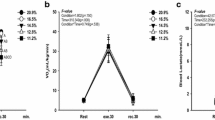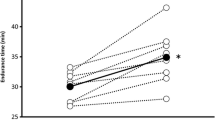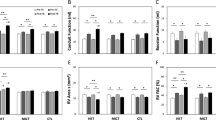Abstract
Acclimatization to intermittent hypoxia (IH) improves exercise performance by enhancing oxygen delivery and utilization, but the effect of IH on hemodynamic control remains unclear. This study investigates how two intensities of IH influence hemodynamic control to develop an IH regimen that improves aerobic fitness and minimizes risk of peripheral vascular disorder. Thirty healthy sedentary men were randomly divided into severe (SIH) and moderate (MIH) IH and control (C) groups. The subjects were exposed to 12% (SIH), 15% (MIH), or 21% (C) O2 for 1 h/day, 5 days/week for 4 weeks in a normobaric hypoxia chamber. The results demonstrate that (1) improved pulmonary ventilation and oxygen uptake by SIH and MIH; (2) SIH elevated blood pressure during exercise and increased plasma malondialdehyde and nitric oxide (NO) metabolite levels, accompanied by reduced hyperaemic arterial response, venous compliance, endothelium-dependent vasodilatation, and decreased plasma total antioxidant and vitamin E levels; (3) while such effects were not seen following MIH; and (4) there were no significant differences in endothelium-independent vasodilatation during all experimental periods among the three groups. We conclude that both SIH and MIH regimens improve pulmonary ventilation. However, SIH but not MIH decreases anti-oxidative capacity and increases lipid peroxidation in circulation, leading to suppression of vascular endothelial function, causing impairment of vascular haemodynamics.






Similar content being viewed by others
References
Agarwal R, Chase SD (2002) Rapid, fluorimetric-liquid chromatographic determination of malondialdehyde in biological samples. J Chromatogr B 775:121–126
Allahdadi KJ, Walker BR, Kanagy NL (2004). Augmented endothelin vasoconstriction in intermittent hypoxia-induced hypertension. Hypertension 45:705–709
Barcelo A, Barbe F, de la Pena M, Vila M, Perez G, Pierola J, Duran J, Agusti AG (2006) Antioxidant status in patients with sleep apnoea and impact of continuous positive airway pressure treatment. Eur Respir J 27:756–760
Benzie IFF, Strain JJ (1996) The ferric reducing ability of plasma (FRAP) as a measure of ‘‘antioxidant power’’: the FRAP assay. Anal Biochem 239:70–76
Cockcroft JR (2005) Exploring vascular benefits of endothelium-derived nitric oxide. Am J Hypertens 18:177S–183S
Darley-Usmar V, White R (1997) Disruption of vascular signaling by the reaction of nitric oxide with superoxide: implications for cardiovascular disease. Exp Physiol 82:305–316
Davidge ST, Ojimba J, McLaughlin MK (1998) Vascular function in the vitamin E-deprived rat: an interaction between nitric oxide and superoxide anions. Hypertension 31:830–835
Elander A, Idstrom JP, Holm S, Schersten T, Bylund-Fellenius AC (1984) Metabolic adaptation in response to intermittent hypoxia in rat skeletal muscles. Adv Exp Med Biol 169:507–513
Forstermann U, Munzel T (2006) Endothelial nitric oxide synthase in vascular disease: from marvel to menace. Circulation 113:1708–1714
Green LC, Wagner DA, Glogowski J, Skipper PL, Wishnok JS, Tannenbaum SR (1982) Analysis of nitrate, nitrite, and [15N]nitrate in biological fluids. Anal Biochem 126:131–138
Huo JZ, Nelis HJ, Lavens P, Sorgeloos P, De Leenheer AP (1996) Determination of vitamin E in aquatic organisms by high-performance liquid chromatography with fluorescence detection. Anal Biochem 242:123–128
Joyeux-Faure M, Stanke-Labesque F, Lefebvre B, Beguin P, Godin-Ribuot D, Ribuot C, Launois SH, Bessard G, Levy P (2005) Chronic intermittent hypoxia increases infarction in the isolated rat heart. J Appl Physiol 98:1691–1696
Katayama K, Sato Y, Morotome Y, Shima N, Ishida K, Mori S, Miyamura M (2001a) Intermittent hypoxia increases ventilation and SaO2 during hypoxic exercise and hypoxic chemosensitivity. J Appl Physiol 90:1431–1440
Katayama K, Shima N. Sato Y, Qiu JC, Ishida K, Mori S. Miyamura M (2001b) Effect of intermittent hypoxia on cardiovascular adaptations and response to progressive hypoxia in humans. High Alt Med Biol 2:501–508
Kato M, Roberts-Thomson P, Phillips BG, Haynes WG, Winnicki M, Accurso V, Somers VK (2000) Impairment of endothelium-dependent vasodilation of resistance vessels in patients with obstructive sleep apnea. Circulation 102:2607–2610
Leuenberger UA, Brubaker D, Quraishi S, Hogeman CS, Imadojemu VA. Gray KS (2005) Effects of intermittent hypoxia on sympathetic activity and blood pressure in humans. Auton Neurosci Basic Clin 121:87–93
McMackin CJ, Vita JA (2005) Update on nitric oxide-dependent vasodilation in human subjects. Methods Enzymol 396:541–553
Morris SJ, Shore AC (1996) Skin blood flow responses to the iontophoresis of acetylcholine and sodium nitroprusside in man: possible mechanisms. J Physiol Lond 496:531–42
Muzaffar S, Shukla N, Angelini GD, Jeremy JY (2005) Acute hypoxia simultaneously induces the expression of gp91phox and endothelial nitric oxide synthase in the porcine pulmonary artery. Thorax 60:305–313
Neubauer JA (2001) Physiological and pathophysiological responses to intermittent hypoxia. J Appl Physiol 90:1593–1599
Phillips SA, Olson EB, Morgan BJ, Lombard JH (2004) Chronic intermittent hypoxia impairs endothelium-dependent dilation in rat cerebral and skeletal muscle resistance arteries. Am J Physiol 286:H388–393
Price DT, Vita JA, Keaney JF (2000) Redox control of vascular nitric oxide bioavailability. Antioxid Redox Signal 2:919–935
Rodriguez FA, Casas H, Casas M, Pages T, Rama R, Ricart A, Ventura JL, Ibanez J, Viscor G (1999) Intermittent hypobaric hypoxia stimulates erythropoiesis and improves aerobic capacity. Med Sci Sport Exerc 31:264–268
Suzuki YJ, Jain V, Park AM, Day RM (2006) Oxidative stress and oxidant signaling in obstructive sleep apnea and associated cardiovascular diseases. Free Radic Bio Med 40:1683–1692
Tahawi Z, Orolinova N, Joshua IG, Bader M, Fletcher EC (2001) Altered vascular reactivity in arterioles of chronic intermittent hypoxic rats. J Appl Physiol 90:2007–2013
Uysal F, Girgin FK, Tuzun S, Aldemir S, Sozmen EY (1998) Effect of vitamin E on antioxidant enzymes and nitric oxide in ischemia-reperfused kidney injury. Biochem Mol Biol Int 44:1255–1263
Villamor E, Kessels CG, Fischer MA, Bast A, de Mey JG, Blanco CE (2003) Role of superoxide anion on basal and stimulated nitric oxide activity in neonatal piglet pulmonary vessels. Pediatr Res 54:372–381
Violi F, Marino R, Milite MT, Loffredo L (1999) Nitric oxide and its role in lipid peroxidation. Diabetes Metab Res Rev 15:283–288
Wang JS (2005) Effects of exercise training and detraining on cutaneous microvascular function in men: the regulatory role of endothelium-dependent dilation in skin vasculature. Eur J Appl Physiol 93:429–434
Wang JS, Cheng L-J (1999) The effect of strenuous acute exercise on α2-adrenergic agonist-potentiated platelet activation. Arterioscler Thromb Vasc Biol 19:1559–1565
Wang JS, Lan C, Chen S-Y, MD, Wong M-K (2002a) Tai Chi Chuan training is associated with enhanced endothelium-dependent dilation in skin vasculature of healthy elderly men. J Am Geriatr Soc 50:1024–1030
Wang JS, Yang CF, Liaw MY, Wong MK (2002b) Suppressed cutaneous endothelial vascular control and hemodynamic changes in paretic extremities with edema in the extremities of patients with hemiplegia. Arch Phys Med Rehabil 83:1017–1023
Wardell K, Jakobsson A, Nilsson GE (1993) Laser Doppler perfusion imaging by dynamic light scattering. IEEE Trans Biomed Eng 40:51–58
Wasserman K, Whipp BJ, Koyl SN, Beaver WL (1973) Anaerobic threshold and respiratory gas exchange during exercise. J Appl Physiol 35:236–243
Wood JG, Mattioli LF, Gonzalez NC (1999) Hypoxia causes leukocyte adherence to mesenteric venules in nonacclimatized, but not in acclimatized, rats. J Appl Physiol 87:873–881
Acknowledgments
The study was support under the National Science Council of Taiwan, Republic of China (grant NSC 95-2314-B-182-006). The authors would like to thank the volunteers for their enthusiastic participation in this study.
Author information
Authors and Affiliations
Corresponding author
Rights and permissions
About this article
Cite this article
Wang, JS., Chen, LY., Fu, LL. et al. Effects of moderate and severe intermittent hypoxia on vascular endothelial function and haemodynamic control in sedentary men. Eur J Appl Physiol 100, 127–135 (2007). https://doi.org/10.1007/s00421-007-0409-8
Accepted:
Published:
Issue Date:
DOI: https://doi.org/10.1007/s00421-007-0409-8




